#ibm pcjr
Explore tagged Tumblr posts
Text




IBM’s Odd Duck: The Life and Times of the PCjr – Dan Fitzgerald
A spectacular commercial failure and a major corporate embarrassment for IBM, the PCjr was a weird little machine priced without a market and given a feature set that left nobody happy. And yet, it managed to leave an impact that would be felt for a generation of PC gamers. Come meet the system that gave the world King’s Quest, the first commercially-available wireless keyboard, and spawned the “Tandy-compatible” PC gaming market of the late 1980s.
VCF East XIX
#vcfexix#vcf east xix#vintage computer festival east xix#commodorez goes to vcfexix#pcjr#ibm pcjr#ibm
41 notes
·
View notes
Text
How is the A3X different from the Amstrad Mega PC or Sega Teradrive?
Easy. It's really more like an IBM PCJr.
The Mega PC and Teradrive were two pretty much separate systems in a single case (an IBM PC and a Megadrive), with a switch on the front to decide which of the two is on screen.
The PCJr was a single system that happened to have both a diskette drive and a cartridge slot.
The A3X also is a single system with both a diskette drive and a cartridge slot. It just also has a console-like tile graphics mode. And any program code running on the A3X, be it from cartridge or disk, can use it.
44 notes
·
View notes
Text
500. The 1984 Olympics Sports Illustrated Preview Issue (July 18, 1984) Part 1.

I'm totally late, but aren't we all having a little bit of Olympic withdrawal? This was a big magazine for me as a kid, big. My mom got it for me at the thrift store in 1994 when I was 10 because at the time I collected old issues of Sports Illustrated for the figure skating articles. This issue was massive, about five hundred pages. Five hundred pages of ads and photos I still remember 30 years later.
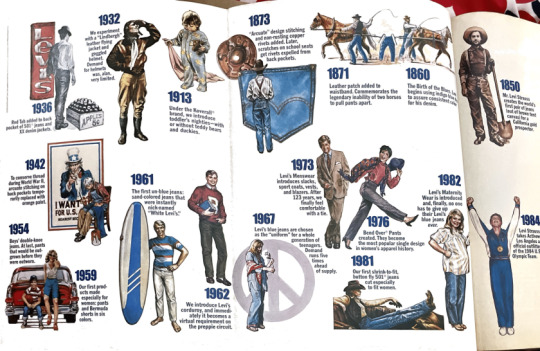
Like this Levi's ad! I still remember the lady in her maternity jeans, and how the kids couldn't wear riveted Levi's to school because they'd scratch up the desks.

There were several extended profiles of athletes that were expected to win big in Los Angeles, such as Carl Lewis.
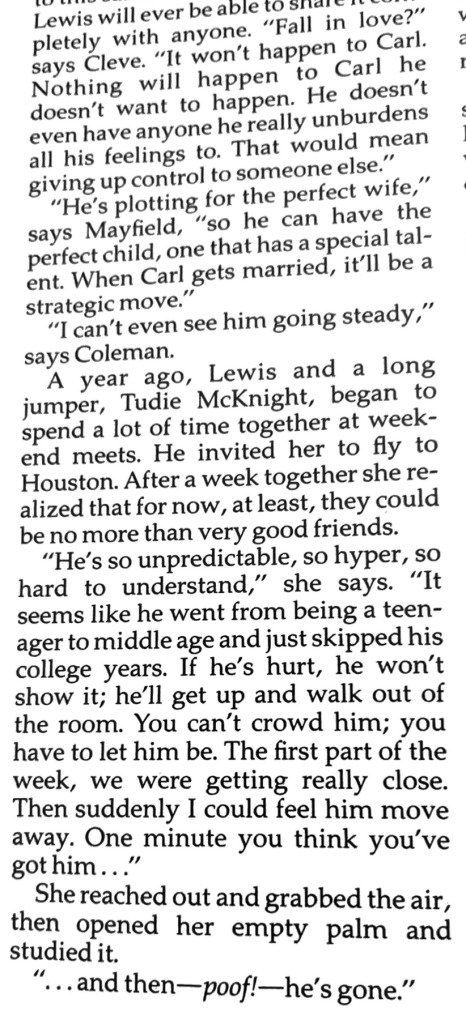

Carl Lewis: mall lover.

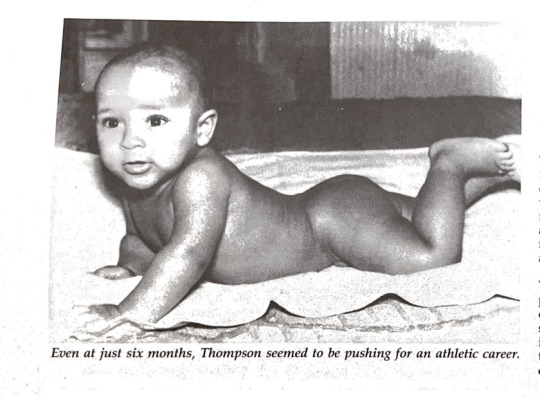
Embarrassing baby photos of the athletes were a common occurrence.

I forgot to mention the Renault Fuego when I did that write up on Renault's short lived visit in the States.
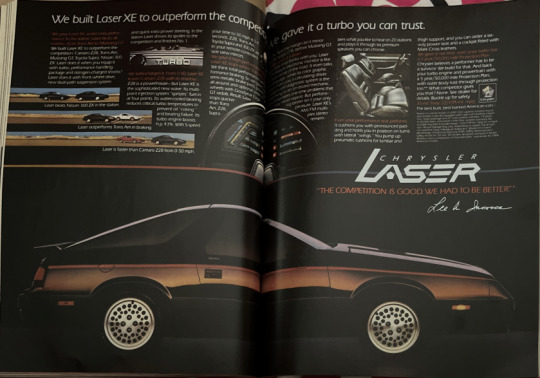
I thought the Chrysler Laser was a thing in Canada, and we in the U.S. had the Plymouth Laser. No! We had the Chrysler first for a couple of years and then we had the Plymouth for a few years? That Lee Iacocca made things so confusing. I've mentioned before that I grew up alongside my niece and when we were in high school, she bought a used green Laser, and I was so jealous.

Autoweek went looking for one of the special 1984 Olympic edition GMC Jimmys, but couldn't find one.
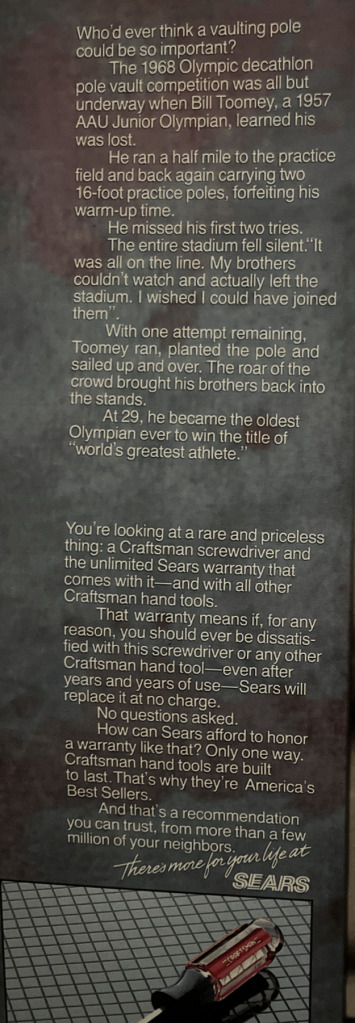
I love that its a heartwarming story about how Bill Toomey almost didn't win the 1968 decathlon, and then its just ...screwdrivers at Sears.
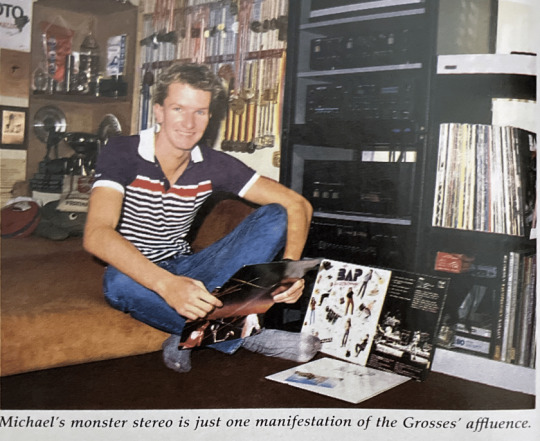
I've spent thirty years trying to figure out what album German swimmer Michael Gross has against his stereo. Bap? Rap? I'm gonna eBay image search it. Okay, so it is a German album by Bap.
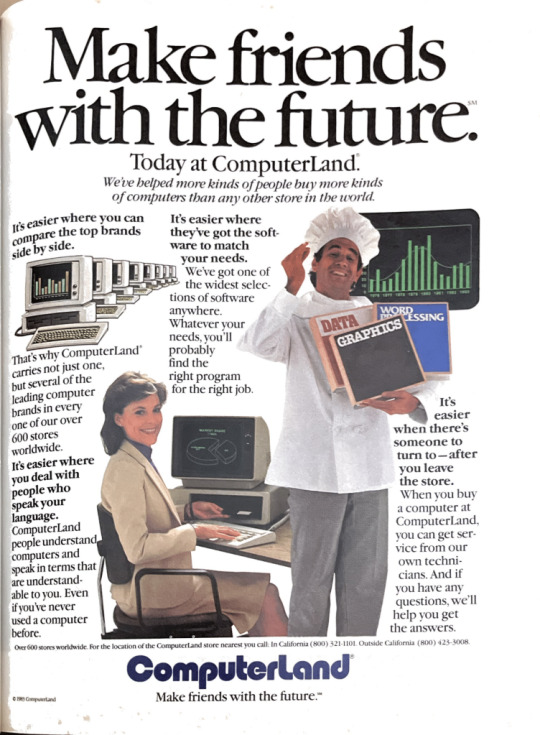
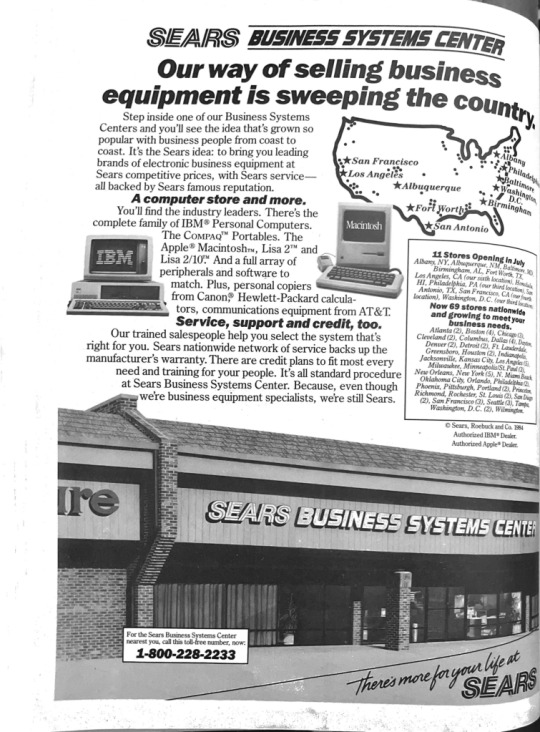
1984 was definitely the first 'puter Olympics. Not the first internet Olympics like Atlanta or Nagano, but one where computers were definitely advertised. Looks like the closest Sears Business Systems Center to me was in Virginia Beach where a Shake Shack is today.

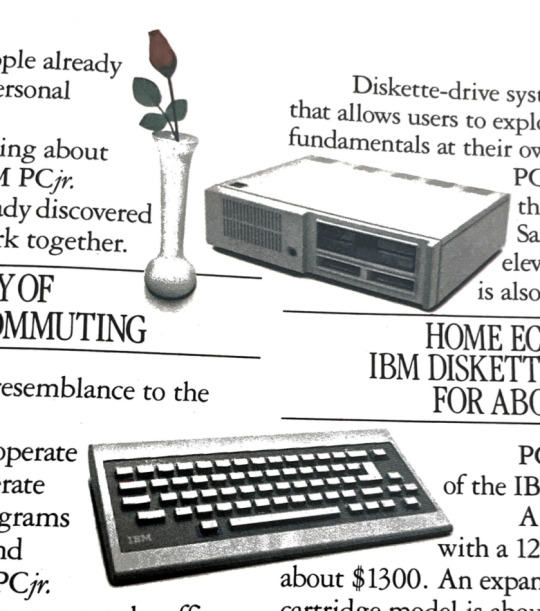
When I was a kid looking at this ad, I thought that was the real Charlie Chaplin, and he was still alive in 1984 selling IBM PCJr computers with those awful keyboards. Clint from LGR called the space bar a "gooey celery stick".

This was a sweet section about athletes reminiscing about their time during the first Olympics held in LA back in 1932. The hop step and jump is what we would call the triple jump today. The Sports Illustrated vault is absolute garbage now, but you can still read the text from the other athletes profiled. Ellen Preis the Frencer from Austria had a heck of a story:
ELLEN PREIS AUSTRIA FENCING, INDIVIDUAL FOIL
When we arrived in the United States, we met the mayor of New York. I can't remember his name [it was Jimmy Walker], but I remember he made a lot of funny jokes. He took us to Sing Sing, which was both interesting and a great shock. We sat in the electric chair. It felt awful. Afterward we saw criminals on Death Row, and I felt very sorry for them. Then they took us to a laboratory, and we saw 42 jars containing the brains of criminals who had died in the chair. I was very young, and it made a strong impression.

I still haven't forgotten this ad, Fisher. It totally worked.
Part 2 coming soon.
Facebook | Etsy | Retail History Blog | Twitter | YouTube Playlist | Random Post | Ko-fi donation | instagram / threads @thelastvcr | tik tok @ saleintothe90s | TeePublic Store
9 notes
·
View notes
Text

In the early 1980s, personal computers were transitioning from text-based interfaces to more visually engaging environments. Sierra On-Line’s King’s Quest: Quest for the Crown, developed in 1984 for the IBM PCjr, was a landmark achievement in this evolution. It was not just another adventure game; it redefined the genre by leveraging the limited hardware capabilities of the time to create an immersive, interactive experience that felt years ahead of its contemporaries. Technical Innovations in King's Quest
1. The Birth of a 3D Adventure Game
At a time when most games were either text-based or limited to simple 2D visuals, King’s Quest introduced a pseudo-3D graphical environment. Players could guide the protagonist, Sir Graham, through a dynamic, scrolling landscape, where he could walk behind or in front of objects—an innovation known as "2.5D."
Pseudo-3D Effect: Achieved through creative use of layers, the AGI (Adventure Game Interpreter) engine divided the screen into foreground, background, and player layers. This gave the illusion of depth and interactivity.
Character Movement: The freedom to move in eight directions and interact with objects in a visually convincing space set a new standard for adventure games.
2. Adventure Game Interpreter (AGI) Engine
Sierra developed the AGI engine specifically for King’s Quest. This software framework was groundbreaking for its time, allowing:
Cross-Platform Compatibility: AGI was portable across different systems, from the IBM PCjr to later platforms like the Apple II and Tandy 1000.
Event-Driven Programming: AGI allowed designers to script events and interactions, decoupling game logic from graphical rendering—a novel approach in the early 80s.
3. Advanced Graphics for the IBM PCjr
The IBM PCjr was an ambitious but underpowered machine, featuring:
Intel 8088 Processor (4.77 MHz): A modest CPU that could struggle with heavy computations.
16-Color Graphics (CGA Palette): While most PCs supported only four colors in CGA mode, the PCjr's extended graphics capabilities allowed for richer visuals.
3-Voice Sound (TI SN76496 Chip): This was a significant improvement over the beeps of the PC speaker, enabling a more immersive auditory experience.
King’s Quest took full advantage of these features:
Rich Color Palette: By designing scenes with careful attention to the 16-color limit, Sierra created lush, vibrant environments that brought the fairytale world to life.
Smooth Animation: Despite hardware limitations, the game’s character animations and environment transitions were fluid and detailed.
4. Text Parser and Command System
While maintaining the classic adventure game tradition of text input, King’s Quest improved upon the interface:
Contextual Parsing: The text parser was more forgiving and sophisticated than previous games, interpreting a wider range of player inputs like "Take sword" or "Open door."
Visual Feedback: Unlike purely text-based games, the parser’s output was directly reflected in the graphical world, making the player’s actions feel meaningful and connected.
5. Disk Streaming and Memory Optimization
Given the IBM PCjr's limited 128 KB of RAM and floppy disk storage, Sierra engineers implemented innovative solutions to manage resources:
Dynamic Asset Loading: Only the necessary graphics, animations, and logic were loaded into memory at a time, minimizing RAM usage.
Compression Techniques: Graphics and animations were heavily compressed to fit on the game’s floppy disks, requiring clever algorithms to decompress assets on-the-fly.
The Impact of King’s Quest
The technical achievements of King’s Quest went beyond its hardware. It had a profound impact on the gaming industry and paved the way for future innovations.
Pushing Hardware to Its Limits: By making the most of the IBM PCjr’s unique capabilities, King’s Quest demonstrated what was possible with even modest computing power.
Setting a Standard for Interactive Storytelling: The game’s rich narrative, combined with its visuals and player agency, set the benchmark for future adventure games.
Expanding the Gaming Audience: The colorful, family-friendly design attracted a broader audience, including casual gamers and younger players.
Influencing Game Design: The AGI engine became the foundation for future Sierra titles, including Space Quest, Police Quest, and Leisure Suit Larry.
#IBM#IBM PCjr#PCjr#Sierra On-line#Sierra Online#On-line Systems#King's Quest#KQ 1#Impact#Pixel Crisis
4 notes
·
View notes
Text
#everyday life#retro gaming#sega#bandai namco#colecovision#atari jaguar#nintendo 64#famicom disk system#sufami turbo#neo geo#commodore 64#ibm pcjr
0 notes
Note
hi whats ur favorite computer. other than the imac g3. :]c if you cant choose one then you can mention multiple.
RAAAAAHHHHH 🔥🔥🔥💯💯💯💯 IBM PC JR !! COMMODORE AMIGA 500 AND 1000 !! BCC MICRO !!! WANG 2200 !!!!!!!!!!!!! AAAAAHH
#asks#THIS IS DIFFICULT AFTER THE IMAC G3 I WOULD SAY IBM PCJR IS MY FAVE AFTER THAT BUT IT PROVES DIFFICULT TO CHOOSE
4 notes
·
View notes
Note
Can I have one that says "This user is a computer[kin]" with cerulean blue text and either a picture of the IBM PCjr or a picture of the computerkin flag? And a webcore theme !!



This user is a computer
--Neo . he/it/xe/ze && Eli . he/him
#mild mannered cannibal .#userbox#techkin#computerkin#machinekin#otherkin#alterhuman#userboxes#this user is
22 notes
·
View notes
Text
Единорогов не существует
29.01.2025

Почему нет возрастных ограничений у этой рекламы клавиатуры!
Ещё прикол — я не знаю ни одной красивой, стильной, умной, девушки в сексуальных красных туфлях и не менее сексуальных чёрных колготках, которая бы такая — "Я пользуюсь механической клавиатурой Вортекс ПиСи 66 в тёмно-сером цвете на 68 клавиш — мне очень нравится, она сделана в ретро стил��, дизайнеры вдохновлялись АйБиЭмом ПиСи Джуниором, очень хорошая вещь и клавиши приятно нажимаются, а у тебя какая клавиатура?"
Зачем рекламщики это делают!? Зачем они играют с чувствами за__тов? Единорогов не существует!
#mechanical keyboard#keyboards#клавиатуры#механические клавиатуры#клавиатура#ibm#русский блог#русский тамблер#русский tumblr#русский пост#russia#жизнь в питере#россия#мысли#красивые#единороги#единорог#она#промдизайн#дизайн#вещи
20 notes
·
View notes
Text
La IBM JX

IBM tenia un ordenador para Australasia, el modelo JX basada en el PCjr. Se fabricaron 40 mil y se vendieron solo 25 mil. Las 15 mil unidades restantes fueron regaladas a empleados, parano admitir que tenían que destruir el exceso. Se descontinuó en 1987. #retrocomputingmx #ibmjx
3 notes
·
View notes
Text
the IBM PCjr is such a cute computer. like theyre just very aesthetically pleasing to my eyes. the platonic ideal of old computers. nicely shaped, chunky, a big square screen, that cute little rainbow logo. it just looks very polite
9 notes
·
View notes
Note
Top 5 worse computers from the 80s
While I'm sure someone could come up with a more definitive well-curated list, here's what I came up with on a whim: Sinclair ZX-81 The ZX-80 was a good, inexpensive step forward for the burgeoning UK computer market. Its successor, the ZX-81, tripped and fell rather than do anything beyond streamlining it for mass production. A real pain in the ass to type on, and notoriously flaky to do any serious work on. Localized in the US as the Timex-Sinclair 1000, it was too weak to really compete with the American market. British users seem to like them but I'd chalk up most of that to nostalgia goggles.
Apple III Apple tried and failed to make a business machine, and Jobs got his way a bit too much, and it overheated alot because he mandated that it couldn't have a fan. Ultimately, it confused people and was surpassed by better Apple II's. A weird footnote in Apple failures.
IBM PCjr The answer to a question that nobody asked. Crappy wireless keyboard, intended to be bolted to your home television. Cartridges? On an IBM? WTF is that? The expansion options are hot garbage. Eventually it was upstaged by the Tandy 1000 at its own game. Just get a PC XT. Or a Tandy.
Coleco Adam Likes to erase its own tapes if you leave them in the drive on power-up due to an electrical surge it shoves through the tape mechanism. The main system power supply is integrated into the printer, so you NEED the chonky printer to be plugged in for it to work. Has those weird phone pad + joystick hybrid controllers. Just get a ColecoVision to play your cartridge games.
Commodore Plus/4 I was going to take a stab at the MAX Machine, but Commodore did worse with the whole concept of the Plus/4. This thing was too cheap for its own good, and went in a completely bonkers direction at the behest of Jack Tramiel. It's supposed to be a cheap business machine to eat the ZX Spectrum's lunch. Why go after the little guy from the UK market? Who knows. Lame rubber chiclet keyboard, totally incompatible with existing Commodore software and most peripherals, and having 121 colors can't save it from being a dumb idea. Apparently it was a hit in eastern Europe.
Remember, pretty much every system has its fanclub, regardless of how flawed, underpowered, or limited a platform it is. So while I personally don't care for any of these machines, if you're mad at me for taking a pot shot at your favorite, do keep in mind that my favorite computer of all time is the VIC-20. You know, the one that most Commodore enthusiasts ignore for only having 5K of RAM having only 8 foreground colors, only 22 columns of screen resolution, and just not being a C64.
24 notes
·
View notes
Text
@imperfectlovesong https://lecollector.net/product/ibm-pc-personal-computer-tablo-paris-hard-enamel-lapel-pin/ <- expensive and not a pcjr BUT better than the tumblr one by far. if anything its cool looking at all the listing photos for this and other pc pins ^_^
#GOD I JUSR REALIZED I NEVER POSTED THIS AHH#this is from 5 days ago from when you posted about the tumblr ibm pin btw ..
14 notes
·
View notes
Note
What's this? There is knocking on your office door. It's not nice to keep them waiting.
Oh dear, there's nobody there .
Nothing down the left hall and nothing-Oh there's a shadow of a person dissapearing to the right.
Are they ok? Do they need help?
The shadow of a person disappears into a back room.
Lights on. It's too dark in there.
It's empty save for a IBM PCjr 4863 Computer sitting on a table in the middle of the room.
.______\/_________.......... |▎▔▔▔▔▔▔▯▯▔▕| \ |▎ || ===| |▎ -` v `- ▕| == / |▎▁▁▁▁▁▁▁▁▁ || K.W. | .________________.______| ▊•«☰☰☰☰»• ▊ ▊ ▊▔▔▔▔▔▔▔▔▔▔▊
\The robotics labs from the Institute is proud to be lending out one of our valued Digital Angels. Please remember to rate your experience once your allotted lending time it up!
\Hello, there valued user! Do not fear, for I will protect you!
\My friends call me Mira. That means you can too!
\Would you like to ask me any questions? Anything at all?
“Huh…”
*The Manager approached the computer slowly.*
“Hello Mira. Can you hear me?”
#malevolent podcast#malevolent spoilers#malevolent#malevolent da capo#malevolent the manager#the manager malevolent#malevolent roleplay#Mira
1 note
·
View note
Text
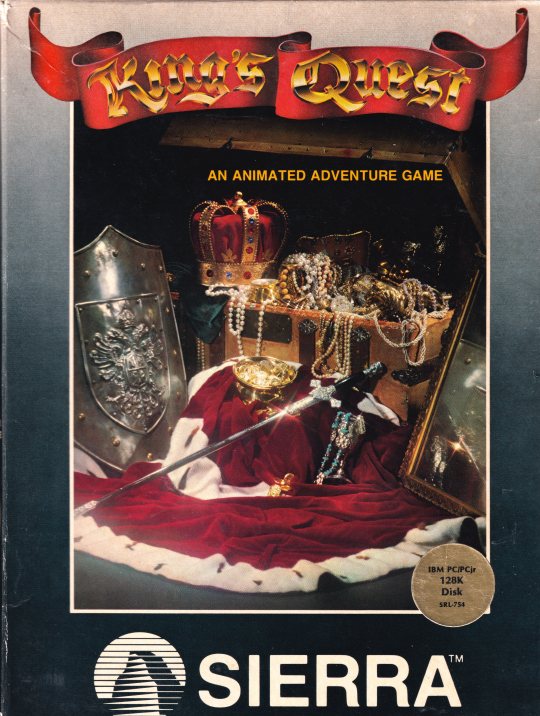
King's Quest for the IBM PC jr
#Sierra#Sierra On-Line#Sierra Online#On-line Systems#King's Quest#Kings Quest#KQ1#King's Quest 1#Kings Quest 1#Retro#Retrogame#Retrogaming#Retro gaming#Retro game#IBM#IBM PC#IBM PCjr#PCjr#PC jr#Really Bad Computer#Pixel Crisis
5 notes
·
View notes
Text
The System 0.97 Dilemma: a Mac anniversary special
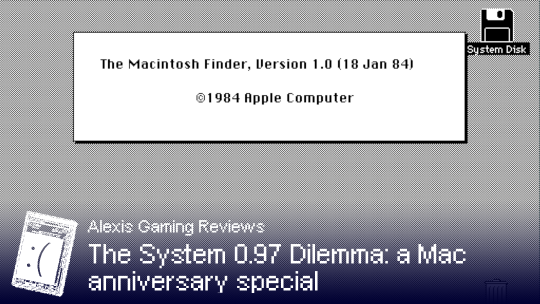
(Originally on my Neocities on January 21, 2024)
Overview
As the anniversary of the original Macintosh approaches, I would tell a short story on how I found clean copies of the System 0.97 disk.
For the uninitiated, the original Macintosh 128K system shipped with
System 1.0, internally System 0.97, since the launch of the model in January 24 to May of 1984, when it was replaced by System 1.1.
The version is essentially a public beta (see Real Artists Ship on folklore.org), but it also became instrumental in the formation of the most important computer line in history (alongside the IBM PC compatible and descendants). While the difference between 1.0 and 1.1
are mostly bug fixes and performance improvements, the disk itself is an important document in the history of the Macintosh line.
Unfortunately, the disks available on the internet are modified, have custom fonts, and other little oddities. Early copies that spread online are unclean, i.e modified so bad that it doesn't resemble the original disk. Because of these, there are attempts on recreating the original experience, while others tried to improve them, but few actually searched for the clean dumps.
Usually, we would check existing archives such as the abundance of Apple Developer CDs, as well as the Legacy Recovery CDs, and few other sources. But lo and behold, the earliest dumps available are from System 1.1, and it's incorrectly labeled, alongside Systems 2.0 to 5.1/4.3. (Further details on this unusual naming scheme is found in earlymacintosh.org.)
I found out about this issue in the middle of November 2023, while reading issues for the Infinite Mac, and been
skeptical about it. I eventually found out this problem that no one, as in no one except a relative few tried to solved.
In this blog post, I would discuss how I did find it, and the
experience, as well as what happened after I found it.
The Modified Disk Problem
In the computers of the era, a hard drive was expensive, albeit large enough for their standards. But the consumer target computers of that particular era rely on different media to store data. Early microcomputer users (such as of Apple II, VIC-20, C64, among others) use audio cassettes to store data, while IBM PC users might be familiar with floppies (IBM PCjr actually does have a cassette drive, fun fact), and maybe a relative few use punch tape. In contrast of the 5.25" floppies that are common in that era, specifically 5.25" 360k disks for the IBM PC, the Macintosh uses a hard shell 3.5" 400k disks for storing data, which is one of it's defining features (a Twiggy disk drive was planned for the Mac, just like the Lisa before it, but due to reliability issues, it was later replaced with a Sony drive).
Early versions of the system use Macintosh File System (MFS), a non-hierarchical file system, that was designed for the 400k disks, which was eventually replaced by the Hierarchical File System (HFS) introduced in System 2.1 (HardDisk 20 Boot). The file system have some
weird quirks to it, such as how it handle folders, even if the design naturally doesn't allow it. One of the interesting things about it was it could write a disk once it opens, if the write-protect notch doesn't exist.
The System 0.97 disk is write-unprotected, which means a user could modify it and add new files such as MacWrite documents into the disk itself. While the properties didn't cause problems initially, the
decision hindered the preservation of those disks, as a user could also alter the whole system as a whole with a copy of ResEdit or with unusual personalization tools, which means modification of the disks. As I also
found out, it could also mean transferring things that aren't supposed in the clean disks (case in font (pun intended), Font Mover and Disk Copy.)
Spread
There are uncertain things about the initial spread of the now-infamous "Pastel font" disks that present System 0.97 with a pastel font, instead of the iconic Chicago font, but the earliest examples are the ones found
in The Mac 512 Usergroup and Gamba's software archive, with Gamba's being the source of modified disks in various sites such as Macintosh Garden, Macintosh Repository and WinWorldPC, among others. Quirks of the disks are that it could load the right font under a Macintosh Plus or an emulator like Mini vMac, and my hypothesis is that the ROM might have a copy of the default font set, or parts of it (as seen by the increased
ROM data capacity).
This spread later with YouTube videos, most using Mini vMac. While I don't see the problem if I looked into a normal viewer's perspective, it does feel off if you actually care about old operating systems. There's a part of me that tells me that these creators didn't do much digging, but in the end of the day, they worked hard enough with creating content, so I respect them.
What's more unfortunate is the fact that the modified copy is prevalent, and somehow still is… until in the middle of November 2023.
The Rabbit Hole
I initiated the search sometime in November 20, or later. I tried searching through Google, digging through old forum sites and popular retro Mac sites, which turned out to be a grueling process. I asked Discord servers, forum sites and Reddit if they have it but I neither have something useful nor have a better answer. And that's when it hit me. Why not make a list of the copies I found through the interwebs? In theory, that should help with the effort.
And then, that night of November 26, 2023, I started work on the gist of the same name,
documenting each copy that I have. During that time, I cataloged many copies from different sites, some copies from the same site. I spent some more time to test if the disks are bootable. Some aren't which I hypothesize the result of it being NDIF format Disk Copy images, as I looked retrospectively.
I also did try digging through shopping sites as well as bidding sites such as eBay but that turned out as not worth my time, as I live in the Philippines, and the conversion rates are high enough that I couldn't afford both the disk itself and the shipping cost. Another problem with this approach is that I don't have either an old Macintosh or a floppy disk drive that could handle 400k disks, or the necessary knowledge to image those disks, as well as where to store once done.
During the same time, I also emailed a few guys, such as ToastyTech (Nathan Lineback) and the webmaster of earlymacintosh.org. I'm initially shocked that the emails are still active. Nathan also told me that he doesn't have a copy but happy to upload it on WinWorldPC once I find it.
The webmaster of earlymacintosh.org however is where I finally found the end of the rabbit hole. It has been November 27 (the following day) when I sent that email, and he responded 2 days later. The disks are there, and to my surprise, it also includes the other disks in the 128K disk set.
Why a disk set? Well, the actual Macintosh 128K box and the models succeeding it actually contains other floppies: System Disk, Guided Tour Disk, MacWrite/MacPaint (bundled in a single floppy or separate) and Guided Tour of MacWrite/MacPaint. Later models omitted MacWrite, MacPaint and the Guided Tour disks as sufficient hard drive capacity became available to everyone, and the models improve performance, and the later transition to PowerPC. The four disks are instrumental to the later success of the Mac, specifically MacWrite and MacPaint.
When checking the disks, it is modified in January 18th, 1984, which is when the disks are printed in after the developers tirelessly pushed out the release (ref. Real Artists Ship), and also exactly 40 years before I
even written the blog post in ghostwriter (markdown editing program). A deep look into the files, it has modified dates between the 18th and the 24th, confirming that it's a clean dump.
As told in the Overview, which I further elaborate, Disk Copy is nowhere to be seen as that piece of application first appeared in System 1.1, initially to easily clone floppy disks, which later evolved into a program also capable of imaging the disks. Font Mover is also nowhere to be seen in the System disk but does appear under the MacWrite/MacPaint disk (disk 2). This is responsible in moving fonts to other systems, later adding the functionality to move disk accessories.
The information about the disk, as far as I was been told was it used to be owned by a developer, that doesn't need the disk. The copies that webmaster had is imaged sometime in January, 2004, but 2 of the disks are redump sometime in June 2018, which is hidden in his private collection of Mac System disk images, mainly from the fear of copyright strikes in his website by Apple themselves, just like the other retro Mac sites from back in the day, but due to my reasoning in the gist, he eventually made it online.
Now in the Interwebs!
It's December. I uploaded the disks after getting his approval on Macintosh Garden and the Internet Archive, some few days later. The disk later made it's way to WinWorld around the same time. I have to check Macintosh Repository if someone uploaded the updated disk sets there.
I only uploaded the System disk and MacWrite/MacPaint disks as the Guided Tour disks, albeit one of them have a never-before-seen betas of MacWrite and MacPaint, is not currently stable under the emulators I have tested, unless heavy modification is done.
On December 22, I filed an issue to Infinite Mac, mainly for adding DC42 support to the site's Mini vMac port. As I was currently in my dad's that time, I have some limitations to do stuff on my big bro's fancier setup (mine is a hand-me-down with new parts), I was testing the Mac stuff while dabbling into emulating a Nintendo Switch game, because I got a collection of old Macintosh disk images while in a bus trip. Since normal Mini vMac 128K can't run MacPaint 1.0 from the disk, DC42 was an easy fix. Then someone finds my research, and the images found their way into the website, both original and modified for Infinite Mac.
By then, I gradually stopped with messing with it as I slowly put Mac OS X into focus (at the time of writing, I'm tinkering with unmodified Tiger DVD booting into KVM via OpenCore and stuff) and more Mac OS X stuff.
The Experience
The actual experience of the operating system is purely just the desktop and the desk accessories. Sure it's revolutionary at the time, but the normal system disk is barren with applications as the disk space is quite limited. The Macintosh 128K's real potential comes down to it's killer applications. Just like how the Game Boy and Tetris is influential, the Macintosh and both MacWrite and MacPaint shows how the Macintosh can do much more than it's contemporaries, possibly even the Lisa before it, as it shows it's power in the desktop publishing industry.
MacWrite is what would you expect a basic word processor nowadays, but back then the program was much more advanced than the competition. Sure, it wasn't exactly the first "what-you-see-is-what-you-get" or WYSIWYG word processor software, but it was a hit among users of the system, as it could effortlessly combine text, pictures and other elements without much complexity to the end-user.
MacPaint is a drawing program, which has a lot of features, and one of the earliest programs to be made for Macs. It could draw things, and more, such as goofy ahh memes of the highest caliber, It also features some fancy (at that time) editing tools, such as the selection tool (Lasso), shape tools, as well as interesting tools such as FatPixels, and others. Later on, the UI style of the program was copied, including, interestingly enough, the Apple II Mouse Card, which is based on a much earlier build of MacPaint (folklore.org), among others.
The desk accessories are basic enough, and are coded cleverly that it could run in background even if there's applications opened, sort of an early attempt at multitasking. It's useful on getting things calculated or copy and pasting stuff from the clipboard desk application or changing the system a bit.
Conclusion
In conclusion, the disk images are finally properly preserved, in a state that everyone could enjoy it. This is a story on how an oftenly ignored issue now solved mainly as I learned much about how to gather stuff, as well as using the search engines to their limits.
I'm sorry if I'm not that often to write stuff, it is what it is. I don't care about the algorithm anymore, I care about doing what I think is the best of my work, and I like what I am doing, as well as the schedule also filled with other things to do such as in school.
Expect more content as well this year, this is only the start. I don't know which topic to do next but I hope I could churn out content much more filled with important stuff and fascinating things about tech, gaming and more.
In the blog post, we discussed how short my finding process is, which is unusually short than most lost or partially found media duration between that status to being found, but I'm still glad that I put a case into rest now, as a pristine copy of System 0.97 is found.
And as always, see you next time!
(also special shout-out to M.D.)
#long read#mac#macintosh#tech#apple#neocities#lisa#macos#apple mac#classic mac#anniversary#please dont read this tag this is an useless tag
0 notes
